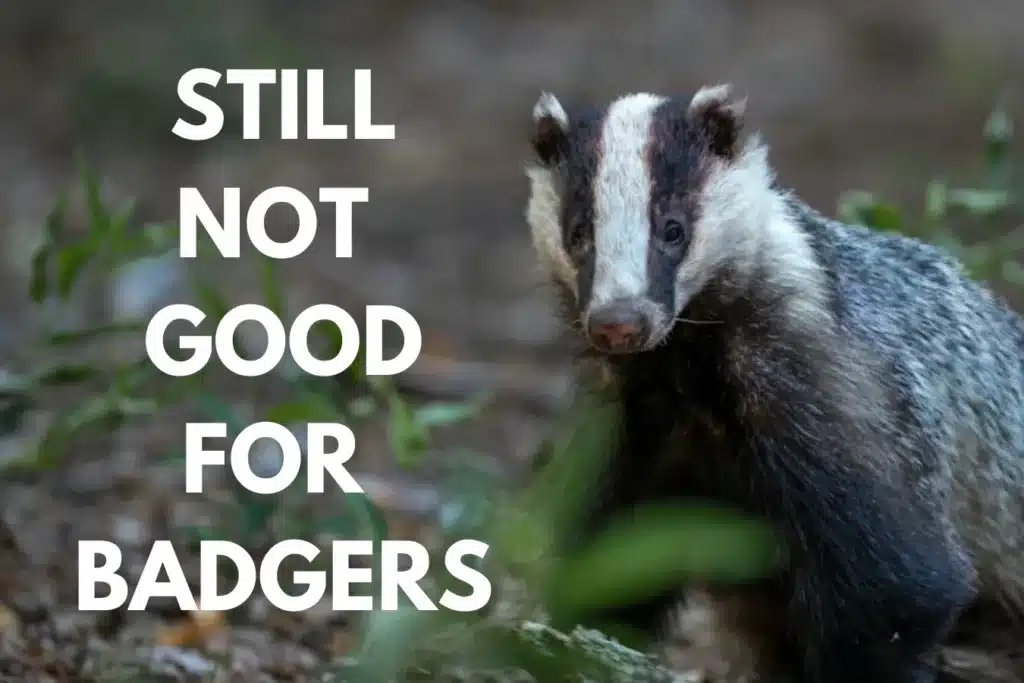On 30 August, Defra announced “Government to end badger cull with new TB eradication strategy”. It was, they said, the “first Bovine TB strategy in a decade to end the badger cull and drive down TB rates to protect farmers’ livelihood.”
On the one hand as a pro-wildlife organisation whose priority is protecting badgers above all else, taking action after the unforgivable inertia of the last decade should be ‘good news’. The previous Conservative government did NOTHING but announce cull zones and compensation to farmers since the killing began in 2013…
But on the other, like the previous government this announcement was geared almost entirely around protecting the dairy industry, and – as before – blaming badgers for catching and spreading Bovine Tb. That’s not what we understand the science to say, and according to interviews in the press, Labour will end the cull as promised but not before ‘the end of a first term’ which in reality means 2029.
In fact, Labour have given themselves every option to INCREASE culling between now and then. As The Badger Crowd homepage puts it “So supplementary and intensive culls will finish at the end of January 2026, and [Low Risk Area] culling with typically 3 years of culls can be started in 2025, 2026 and 2027.”
Tens of thousands of badgers are still under threat, then…

Photo by Vincent van Zalinge on Unsplash
Four Bullet Points – three of them specifically for the farming industry
- “First badger population survey in over a decade: The last major badger survey was carried out between 2011-13, leaving policy makers with no clear idea of the impact culling techniques have on our badger populations. The Government will work at pace to launch a new survey this winter to estimate badger abundance and population recovery to illustrate the impact of widespread culling over the past decade.”
- New national wildlife surveillance programme: After a decade of culling, the prevalence of TB in remaining badger populations is largely unknown. The development of a new national wildlife surveillance programme will provide an up-to-date understanding of disease in badgers and other wildlife such as deer. Together with updated estimates of badger abundance, this will unlock a data-driven approach to inform how and where TB vaccines and other eradication measures are rapidly deployed to drive down TB rates and protect farmers’ livelihoods.
- Establish a new Badger Vaccinator Field Force: Badger vaccinations create progressively healthier badger populations that are less susceptible to catching and transmitting TB. A new Badger Vaccinator Field Force will increase badger vaccination at pace to drive down TB rates and protect badgers.
- Badger vaccination study: To supplement the Field Force, the Government will rapidly analyse the effect of badger vaccination on the incidence of TB in cattle to encourage farmers to take part and provide greater confidence that doing so will have a positive effect on their cattle.
Badger survey and surveillance programme
Notoriously difficult to survey and prone to wandering when disturbed or new territories open up, it has been an absolute travesty that the mass slaughter of badgers – protected species with an internationally important population here in the UK – has taken place with no idea how many badgers there are or what impact culling has had on their numbers. Especially when the cull ‘targets’ were set at 70% of a cull area population. That is not only patently unscientific but gave cullers a green light to wipe out every badger they saw because no one could say definitively what that 70% figure represented on the ground.
Little meaningful can realistically be achieved in one year of a survey even with the full cooperation of every badger group in the country: without a promise that revealing sett data won’t mean a visit from a culler it seems unlikely a government that hasn’t stopped the cull will get that. How complete can a survey be when the very people you need to carry it out feel let down and distrustful? And how long will it actually take?
We are also immensely sceptical about how – without a proper baseline – data obtained can be used as a way to scientifically determine (rather than guess) the impacts of more than a decade of culling anyway. And as importantly how will any data be used? Will it (as happened with the ‘Woodcock Survey’ birders were invited to join by shooting lobbyists GWCT) be used to justify or to continue killing badgers?
Given that Defra says surveillance “will unlock a data-driven approach to inform how and where TB vaccines and other eradication measures [our highlighting] are rapidly deployed to drive down TB rates and protect farmers’ livelihoods”, that seems likely to be the case.
Are we opposed to a survey then? We would need far more clarity about what form the survey will take, who will be collecting the data, who will have access to it, and how it will be used before we can answer that…

Vaccination
If badgers are to be vaccinated to protect them from Bovine TB that is being passed to them from cattle, that is very different from saying badgers must be vaccinated to protect cattle from catching Bovine Tb from them. One can be seen as an effort to protect badgers from a disease of cattle, the other is blaming them for passing it around.
There are some rather imaginative leaps in Defra’s announcement. There is no doubt some badgers carry bTb but we don’t know how many (because very few culled badgers have ever been tested), and we don’t know whether otherwise healthy badgers are impacted by it. Vaccination programmes are expensive (the government estimated in 2013 between £2,000 and £4,000 per km2) and to have any meaning at all, they will have to be carried out across vast areas of England. Huge numbers of badgers will then have to be tested and retested for disease after vaccination for any meaningful data to be collected. If they can carry the disease without much ill-effect anyway, what will that testing actually prove that would be beneficial to badgers?
We are very sceptical that as far as the government goes this proposal is about ‘healthy badgers’ at all, and it seems pretty clear when Defra says “vaccinations create progressively healthier badger populations that are less susceptible to catching and transmitting TB” they are leaning heavily towards mass vaccination to protect cattle.
Who will carry out the vaccinations anyway? Some badger groups already carry out badger vaccinations but nowhere near enough to scale up to what is needed. This could be yet more enormous wastage of public funds spent on killing badgers, all going into the pockets of who the heck knows – it may not be reaching the level of the PPE scandal, but there will be people (and the public really ought to be told exactly who) making vast amounts of money from programmes that may not give badgers protection at all.
Do we oppose vaccination then? If it means fewer farmers killing badgers who could think that is a ‘bad thing’, but if this is simply the government clinging to outdated and disproven science, though, then we of course have reservations. Especially if it means diverting any funds from developing proper cattle vaccination or implementing iron-clad biosecurity regimes on cattle movements.
Again, we need far more clarity and information than was in this announcement before we will commit definitively either way…

This is NOT ‘badgers first’
That promise was not in the manifesto, it has not been made (as far as we can tell) in the news, and it has not been made on social media.
As things stand, it appears that every single government action is being taken to protect an industry that produces a food we don’t actually need, causes immense suffering to the cows involved, and is a proven factor in the climate crisis that is threatening to engulf us all.
It is not about the supposedly protected animal that has lived here since the last Ice Age and which will be hunted and killed for at least the next five years.

